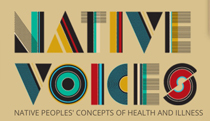Native Voices: Native Peoples’ Concepts of Health and Illness
Exhibit at the National Library of Medicine
Sweat lodges, herbal medicine, and a model Hōkūle`a, a Native Hawaiian voyaging canoe. These are just a few of the elements in the National Library of Medicine’s (NLM’s) Native Voices exhibit, which explores the connection between wellness, illness, and cultural life through a combination of interviews with Native people, artwork, objects, and interactive media.

MONICA MENDOZA, U.S. AIR FORCE PHOTO
Michael Hackwith, (U.S. Marine Corps, retired) Lakota spiritual leader, and sweat lodge [Inipi], 2010. The sweat lodge ceremony was first practiced by the Plains Indians and has spread to many other tribes. A sweat lodge is typically a tent-like structure that traps heat under blankets or animal hides, promoting wellness by cleansing and purifying the body and spirit.
The exhibit displays the NIH’s “growing admiration for many of the ideas and practices of Native Peoples and highlights their beliefs about the importance of nature, tradition, and community in healing,” explained NLM Director Donald Lindberg in an introductory video.
Despite advances in Western medicine in treating many types of illness, traditional Native healing practices have recently been recognized by the U.S. Department of Veterans Affairs (VA) for their value in therapeutic healing treatments and their potential to teach modern medicine a few valuable lessons. The exhibit features riveting interviews with Native Americans, Alaska Natives, and Native Hawaiians, collectively called Native Peoples, on their concepts of health and illness.
Although traditional healing methods may be unable to cure terminal illnesses such as cancer, the American Cancer Society credits them with reducing pain and stress while improving the quality of life. This holistic approach to treatment underlines the idea that “wellness of the individual is inseparable from harmony within the family and community and pride in one’s heritage,” according to one of the exhibit displays. Ceremonies such as the Hawaiian Ho’oponopono, a kind of family conference that focuses on restoring and maintaining healthy relationships within a family or with God, are valuable for maintaining a community’s order, peace, and trust.
Many traditional healing ceremonies reaffirm one’s commitment to living a healthy and productive life. They form the basis of treatment and create a dialogue to release people from feelings of guilt. For example, the Navajo Enemy Way Ceremony helps restore a returning soldier’s “state of balance, or beauty, within the universe.” The ceremony helped the Code Talkers: Navajos, Choctaws, Cherokees, and other Native Peoples who used their languages to enable the U.S. military to transmit coded messages during both world wars. The Code Talkers not only were subjected to the normal stresses of war—they also had the added stress of being ordered to take oaths of silence about their crucial wartime contributions. Fortunately, they were allowed to participate in spiritual ceremonies including the Navajo Enemy Way Ceremony, which helped them “sustain connections with family, community, and Native culture.” The VA also recognizes that this type of holistic, community-oriented healing approach is helpful to any veteran who is recovering from post-traumatic stress disorder.
Although ceremony and community-focused healing distinguish traditional healing methods from Western medicine, many facets of each approach are similar. For instance, Native games—built on tests of strength and displays of survival skills—and modern medicine’s push to exercise both emphasize the value of being fit and healthy.
Traditional healing practices also offer Western medicine ideas for new methods of engaging with not only the individual but also with their communities.

To view NLM’s “Native Voices: Native Peoples’ Concepts of Health and Illness” exhibit online, go to http://www.nlm.nih.gov/nativevoices. The exhibit is also open to visitors from 8:30 a.m. to 5:00 p.m., Monday–Friday (except federal holidays), in Building 38.
This page was last updated on Tuesday, April 26, 2022
